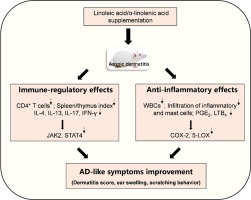Journal of Functional Foods ( IF 3.8 ) Pub Date : 2020-01-09 , DOI: 10.1016/j.jff.2019.103754 Liu Tang , Xiaolei Li , Liping Wan , Huiling Wang , Qianting Mai , Zixin Deng , Hong Ding

|
The present research was designed to evaluate the protective effects and underlying mechanisms of different ratios of linoleic acid (LA) and α-linolenic acid (ALA), two essential polyunsaturated fatty acids (PUFAs) fatty acids, on atopic dermatitis (AD)-like skin lesions induced by 2, 4-dinitrofluorobenzene (DNFB). The dorsal flank and ear pinnas of mice were sensitized and challenged with DNFB for four weeks in order to establish AD model. Simultaneously, the mice were orally administered different ratios of LA/ALA (v/v; 4:1 or 1:1), or dexamethasone (Dex; 0.1 mg/kg). Results showed that different LA/ALA ratios, especially a ratio of 4:1 treatment, could effectively ameliorate DNFB-induced skin lesions, ear edema, scratching behavior and skin inflammation, as reflected by the reduced inflammatory blood cells, IgE serum levels, and skin levels of the pro-inflammatory lipid mediators, including PGE2 and LTB4. These findings were further confirmed by skin pathological examination. Moreover, LA/ALA administration markedly suppressed the proliferation and infiltration of T cells, the production of T helper cell type 1 (Th1), Th2 and Th17 cytokines in dorsal skin and serum of DNFB-treated mice. Western blotting and immunohistochemistry staining revealed that LA/ALA downregulated the protein expressions of JAK2 and STAT4, and thus reducing the synthesis of type Th1 cytokine IFN-γ. Taken together, these results suggest that optimal nutrition ratio of LA/ALA has beneficial effects on AD-like symptoms, which provide theoretical basis for its therapeutic potential in the clinical prevention and treatment of AD.
中文翻译:

口服不同亚油酸/α-亚麻酸比例对DNFB诱发的特应性皮炎小鼠模型的改善作用
本研究旨在评估不同比例的亚油酸(LA)和α-亚麻酸(ALA)这两种必需的多不饱和脂肪酸(PUFAs)脂肪酸对特应性皮炎(AD)样的保护作用及其潜在机制2、4-二硝基氟苯(DNFB)引起的皮肤损伤。用DNFB敏化并攻击小鼠的后胁和耳廓四个星期,以建立AD模型。同时,给小鼠口服不同比例的LA / ALA(v / v; 4:1或1:1)或地塞米松(Dex; 0.1 mg / kg)。结果表明,不同的LA / ALA比值,尤其是4:1的比值,可以有效地缓解DNFB引起的皮肤损伤,耳水肿,抓挠行为和皮肤炎症,这可以通过减少炎症性血细胞,降低IgE血清水平来体现,2和LTB 4。皮肤病理检查进一步证实了这些发现。此外,LA / ALA给药显着抑制了DNFB治疗小鼠的背部皮肤和血清中T细胞的增殖和浸润,T型辅助细胞1(Th1),Th2和Th17细胞因子的产生。Western印迹和免疫组织化学染色显示,LA / ALA下调了JAK2和STAT4的蛋白表达,从而减少了Th1型细胞因子IFN-γ的合成。综上所述,这些结果表明LA / ALA的最佳营养比例对AD样症状具有有益作用,为其在AD临床预防中的治疗潜力提供了理论基础。











































 京公网安备 11010802027423号
京公网安备 11010802027423号